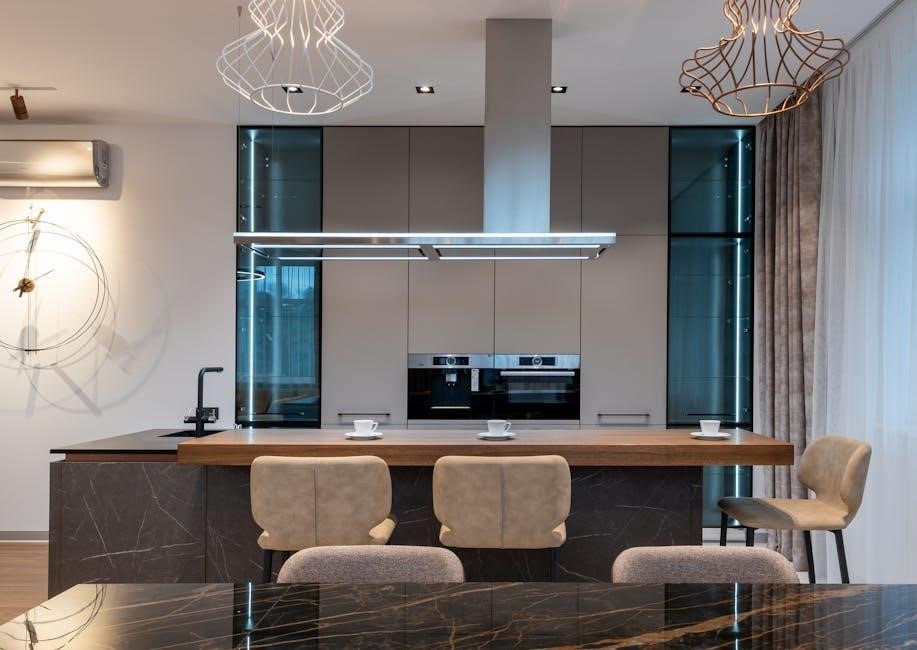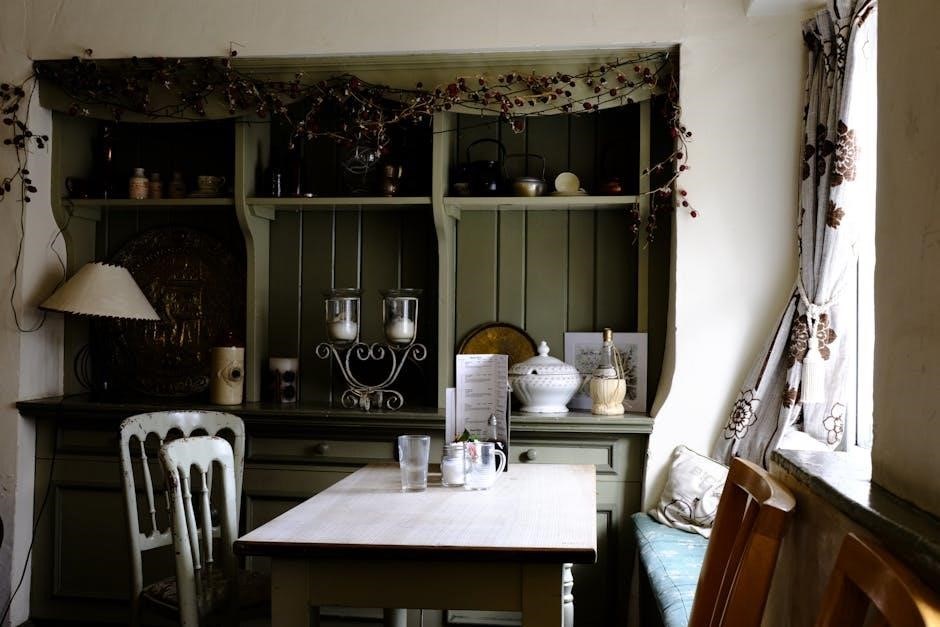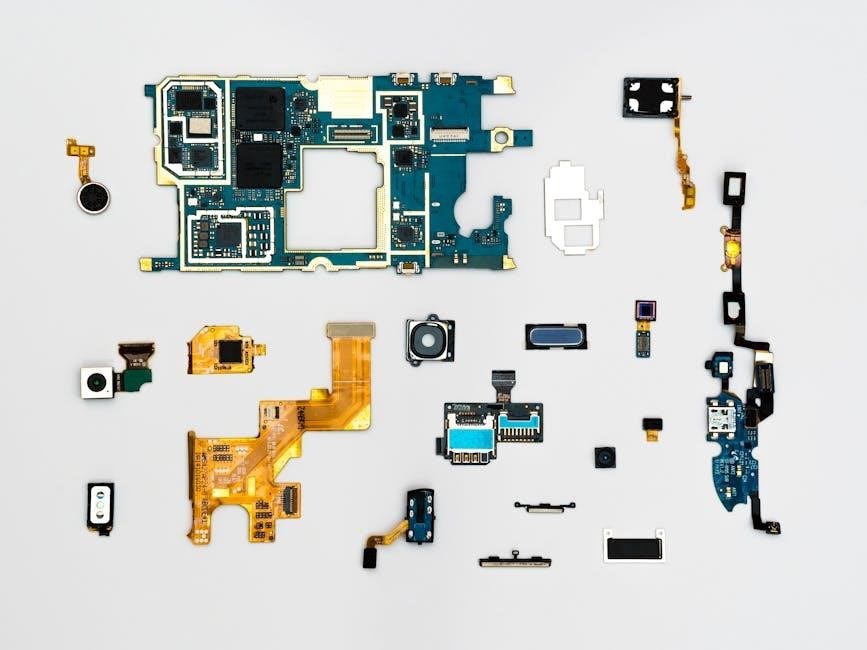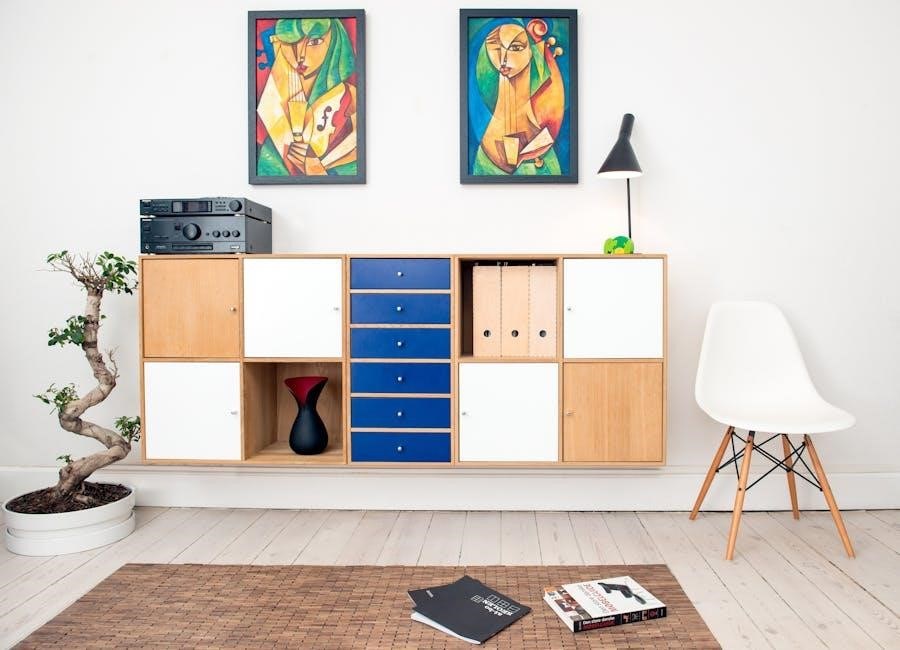Welcome to the Whirlpool WTW4816FW2 Service Manual, your comprehensive guide to understanding, maintaining, and troubleshooting your washer. This manual provides detailed insights into features, installation, and operation.
1.1 Overview of the Manual
This section provides a concise summary of the entire service manual, highlighting its purpose and content. It serves as a roadmap, helping users navigate through the detailed information provided.

The manual is divided into key sections, including safety guidelines, product features, installation instructions, operating procedures, troubleshooting, and maintenance tips. Each part is designed to ensure safe and effective use of the Whirlpool WTW4816FW2 washer.
By understanding the manual’s structure, users can quickly locate specific information, whether they are installing, operating, or servicing the appliance. This overview ensures a smooth experience for both professionals and homeowners.
1.2 Purpose and Scope
The purpose of the Whirlpool WTW4816FW2 Service Manual is to provide users with a detailed guide for the safe and effective use, maintenance, and repair of the washer. It serves as a comprehensive resource for both professionals and homeowners.
The scope of this manual includes installation requirements, operational guidelines, troubleshooting common issues, and maintenance procedures. It also covers technical specifications, safety precautions, and diagnostic processes to ensure optimal performance and longevity of the appliance.
By following the manual, users can address various aspects of the washer’s care, from routine cleaning to complex repairs, ensuring reliability and efficiency in its operation. This manual is designed to be user-friendly, making it accessible to individuals with varying levels of technical expertise.
1.3 Structure and Organization
The Whirlpool WTW4816FW2 Service Manual is organized into clear, logical sections to ensure easy navigation and quick access to information. The manual is divided into numbered sections, each focusing on specific aspects of the washer, such as installation, operation, and troubleshooting.

Each section is further subdivided into detailed subheadings, providing in-depth guidance on topics like safety precautions, technical specifications, and maintenance procedures. This structured approach allows users to locate relevant information efficiently, whether they are professionals or homeowners.
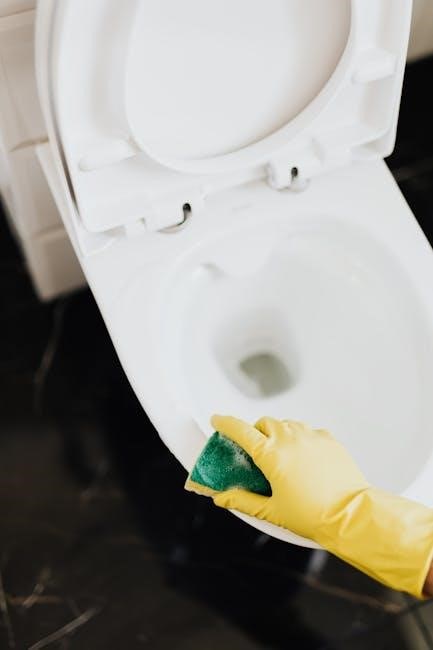
The manual’s organization ensures that all aspects of the washer’s care and repair are covered comprehensively, making it an essential resource for anyone working with the Whirlpool WTW4816FW2.
Safety Guidelines and Precautions
Adhering to safety practices is crucial when working with the Whirlpool WTW4816FW2. This section outlines essential precautions to prevent hazards and ensure safe operation and maintenance.
2.1 General Safety Precautions
Adhering to safety guidelines is essential when working with the Whirlpool WTW4816FW2. Always unplug the washer before performing any maintenance or repairs to prevent electrical shocks. Wear protective gear, such as gloves and safety glasses, to avoid injuries. Ensure the washer is on a level surface to prevent tipping. Never bypass safety features or tamper with electrical components, as this can lead to serious hazards. Keep children and pets away during operation or servicing. Follow all instructions carefully, and avoid overloading the washer, as this can cause imbalance and potential damage. Regularly inspect hoses and connections for signs of wear or damage. By following these precautions, you can ensure a safe and efficient experience with your Whirlpool WTW4816FW2 washer.
2.2 Specific Safety Warnings
The Whirlpool WTW4816FW2 service manual highlights several specific safety warnings to ensure safe operation and maintenance. Avoid overloading the washer, as this can cause imbalance and potential damage. Never operate the washer with damaged or worn-out parts, as this may lead to mechanical failure. Keep loose clothing and long hair tied back to prevent entanglement with moving parts. Do not attempt to bypass safety features or modify the washer’s design, as this can result in serious injury or electrical hazards. Always follow the recommended cycle settings and detergent usage to avoid over-sudsing or malfunction. Additionally, never leave children unattended near the washer while it is in operation. Failure to adhere to these warnings may void the warranty or cause harm. Always refer to the manual for specific guidelines.
2.3 Compliance with Safety Standards
The Whirlpool WTW4816FW2 service manual ensures compliance with international safety standards, guaranteeing safe and reliable operation. The washer is designed to meet UL (Underwriters Laboratories) and IEC (International Electrotechnical Commission) certifications, ensuring adherence to strict safety protocols. These standards cover electrical safety, mechanical integrity, and environmental considerations. The manual emphasizes the importance of following these guidelines to prevent hazards and maintain warranty validity. Regular testing and certification processes ensure the washer operates within established safety parameters. By complying with these standards, Whirlpool ensures the WTW4816FW2 is both user-friendly and secure for long-term use. Always refer to the manual for specific compliance details and updates.
Product Features and Specifications
The Whirlpool WTW4816FW2 offers a large 4.8 cu. ft. capacity, multiple wash cycles, and energy-efficient operation, making it a versatile and reliable choice for household laundry needs.
3.1 Design and Build Overview
The Whirlpool WTW4816FW2 features a sturdy and modern design with a focus on durability and user convenience. The washer is built with high-quality materials, including a rust-resistant stainless steel tub, ensuring long-lasting performance. Its compact yet spacious interior allows for larger loads without compromising on energy efficiency. The exterior is designed with a durable finish that resists scratches and fading, maintaining its appearance over time. The control panel is intuitive and user-friendly, with clear buttons and a digital display for easy cycle selection. The overall build emphasizes reliability and quiet operation, making it suitable for both small and large households. This design ensures the washer remains a dependable and efficient addition to any laundry room.
3.2 Key Features of the WTW4816FW2
The Whirlpool WTW4816FW2 boasts an array of innovative features designed to enhance your laundry experience. It includes advanced wash technology for superior cleaning performance and multiple preset cycles tailored to different fabric types. The washer also features energy-efficient operation, reducing water and electricity consumption while maintaining powerful cleaning results. Additionally, it is equipped with a smart diagnostic system to quickly identify and resolve issues. The quiet operation ensures minimal noise during cycles, making it ideal for households with varying schedules. With its intuitive control panel and large capacity tub, this washer offers convenience, efficiency, and reliability for all your laundry needs.
3.3 Technical Specifications
The Whirlpool WTW4816FW2 washer is designed with precise engineering, featuring a 4.8 cu. ft. capacity to handle large loads efficiently. It operates on 120V, 60Hz power requirements, ensuring compatibility with standard household electrical systems. The washer has a stainless steel tub for durability and resistance to corrosion. With a maximum spin speed of 1200 RPM, it effectively removes moisture from clothes, reducing drying time. The unit measures 27 inches in width, making it a space-saving addition to most laundry areas. It also includes a quiet operation feature, minimizing noise during cycles. The washer is ENERGY STAR certified, indicating its energy efficiency and environmental friendliness. These specifications ensure reliable performance and long-term durability for your laundry needs.
Installation and Setup
Proper installation ensures optimal performance and safety. Ensure the site is prepared, and all electrical and plumbing connections are secure. Level the washer to prevent vibration and noise. Always follow the manual’s specific instructions for a successful setup.
4.1 Site Preparation and Requirements
Proper site preparation is essential for safe and efficient installation of the Whirlpool WTW4816FW2 washer. Ensure the installation area is level, firm, and dry. The floor must be sturdy enough to support the washer’s weight when fully loaded. Avoid placing the washer near direct sunlight or extreme temperatures. Ensure adequate ventilation to prevent moisture buildup. The area should be clear of obstructions, with enough space for easy access and maintenance. Check that all necessary utilities, such as water and electrical connections, are within reach. Follow the manual’s guidelines for floor leveling and anti-vibration measures to ensure smooth operation and minimize noise.
4.2 Electrical and Plumbing Connections
Ensure the Whirlpool WTW4816FW2 washer is connected to a grounded, 120V, 60Hz electrical outlet. Use a dedicated 20-amp circuit to avoid power issues. For plumbing, connect the washer to cold and hot water supplies using 3/4″ hoses. Install a shut-off valve near the washer for easy access. Check all connections for leaks before operation. Ensure the drain hose is securely connected to a standpipe or laundry tub, maintaining the recommended height to prevent siphoning. Verify that all connections comply with local plumbing codes. If unsure, consult a licensed professional to ensure proper installation and safety.
4.3 Venting and Drainage Setup
Proper venting and drainage are essential for optimal performance of the Whirlpool WTW4816FW2 washer. Ensure the venting system uses rigid or flexible ducts, maintaining a clear path to the exterior to prevent moisture buildup. The vent cap should be securely installed to avoid blockages. For drainage, position the drain hose correctly to prevent siphoning, ensuring it doesn’t extend beyond the standpipe or tub. The standpipe should be between 30″ and 48″ high to facilitate proper water flow. Regularly inspect the venting and drainage systems for blockages or kinks. Ensure all connections are secure and comply with local plumbing codes to avoid leaks or water damage. Proper setup ensures efficient operation and prevents potential issues.

Operating the Washer
Learn to operate your Whirlpool WTW4816FW2 washer efficiently. Understand cycle selection, loading procedures, and essential operation tips for optimal performance and fabric care.
5.1 Overview of the Control Panel
The control panel of the Whirlpool WTW4816FW2 is designed for intuitive operation. It features a clear display screen, buttons for cycle selection, and a dial for adjusting settings. Key components include the power button, start/stop control, and options for temperature, spin speed, and soil level. The panel also displays error codes and status updates, ensuring easy monitoring of the wash cycle. LED indicators provide visual feedback for selected options, while the layout ensures seamless navigation. This user-friendly interface allows you to customize wash cycles, monitor progress, and address issues promptly, making laundry tasks efficient and stress-free.
5.2 Cycle Selection and Options
The Whirlpool WTW4816FW2 offers a variety of pre-programmed wash cycles to suit different fabric types and soil levels. Key cycles include Normal, Heavy Duty, and Delicate, each optimized for specific needs. Additional options allow customization, such as temperature selection (hot, cold, or warm), spin speed adjustment, and soil level indicators. The washer also features specialized settings like a deep clean mode for heavily soiled items and a quick wash option for time-saving convenience. These customizable options ensure efficient cleaning while protecting fabrics. The intuitive design makes it easy to tailor cycles to your laundry needs, ensuring optimal performance and care for your clothes.
5;3 Loading and Balancing the Washer
Proper loading and balancing are crucial for optimal performance of the Whirlpool WTW4816FW2. Load size should match the selected cycle, avoiding overloading to prevent damage. Distribute clothes evenly to maintain balance, ensuring stable operation. Large or heavy items like blankets should be balanced with smaller loads. Overloading can cause vibration and noise, while underloading may reduce efficiency. Check the washer’s balance during operation; if it vibrates excessively, adjust the load. For best results, follow the recommended load capacity and ensure the washer is level during installation. Proper loading enhances cleaning performance and extends the appliance’s lifespan. Always refer to the manual for specific guidelines on load sizes and balancing techniques.

Troubleshooting Common Issues
This section helps identify and resolve common problems with the Whirlpool WTW4816FW2, such as error codes, unusual noises, or the washer not starting. Refer to the manual for solutions.

6;1 Identifying Common Problems
Identifying common issues with the Whirlpool WTW4816FW2 washer involves recognizing symptoms like error codes, unusual noises, or the washer not starting. Error codes such as “E1” or “E2” often indicate specific malfunctions, like sensor issues or drainage problems. Strange noises during operation may point to imbalanced loads or worn-out parts. If the washer fails to start, check power supply, circuit breakers, and control panel functionality. Refer to the manual for a list of error codes and their meanings. Regular maintenance, such as cleaning filters and ensuring proper ventilation, can prevent many of these issues. Early detection of problems helps avoid costly repairs and ensures optimal performance.
6.2 Error Codes and Their Meanings
The Whirlpool WTW4816FW2 washer uses specific error codes to indicate malfunctions. Codes like “E1” or “E2” typically relate to sensor issues or drainage problems. “E3” may indicate a heating element malfunction, while “E4” could signal a door lock failure. “E5” often points to a motor or control board issue. Understanding these codes helps in diagnosing problems accurately. Refer to the manual for a detailed list of codes and their corresponding solutions. Addressing these issues promptly ensures efficient troubleshooting and prevents further damage to the washer. Regular maintenance, such as cleaning filters and checking connections, can help minimize errors and maintain optimal performance.
6.3 Diagnostic Procedures
Diagnosing issues with the Whirlpool WTW4816FW2 washer involves a systematic approach. Start by checking the error codes displayed on the control panel, as they provide specific clues about the problem. Next, perform a visual inspection of the washer’s exterior and interior for signs of damage or blockages. Test the power supply and ensure all connections are secure. If the issue persists, run a diagnostic cycle, if available, to identify faulty components. For complex problems, consult the service manual for detailed troubleshooting steps. Regularly cleaning the drain pump filter and checking for imbalanced loads can also prevent many common issues. Always unplug the washer before attempting internal inspections or repairs to ensure safety.

Maintenance and Upkeep
Regular maintenance ensures optimal performance and longevity of the Whirlpool WTW4816FW2. Clean the gasket, check for blockages, and run cleaning cycles to prevent mold and odors.
7.1 Routine Cleaning and Care
Regular cleaning is essential to maintain the performance and hygiene of your Whirlpool WTW4816FW2 washer. Start by wiping down the exterior with a damp cloth to remove dust and detergent residue. Clean the gasket and seals after each use to prevent mold and mildew buildup. Check and clean the drain pump filter regularly to ensure proper water flow. Run a cleaning cycle every 1-2 months using a washer cleaner or hot water to remove detergent residue and odors. Additionally, leave the lid open after use to allow the interior to dry, preventing moisture buildup. Regularly inspect and clean the detergent dispenser to ensure optimal performance. By following these steps, you can keep your washer in excellent condition and extend its lifespan.
7.2 Checking and Replacing Parts
Regularly inspecting and replacing worn or damaged parts is crucial for maintaining your Whirlpool WTW4816FW2 washer’s performance. Start by checking the drain pump filter for blockages and cleaning it as needed. Inspect the door gasket and seals for signs of wear or mold, replacing them if necessary. Check the hoses for cracks or leaks and replace them every 6-12 months. Lubricate moving parts like hinges and rollers to ensure smooth operation. If you notice unusual noises or vibrations, inspect the balance ring or shock absorbers for damage. Always refer to the manual for specific replacement procedures and use genuine Whirlpool parts to ensure compatibility and optimal performance. Regular checks can prevent major repairs and extend the washer’s lifespan.
7.3 Deep Cleaning the Washer
Deep cleaning your Whirlpool WTW4816FW2 washer is essential for maintaining hygiene and performance. Start by running a cleaning cycle with a washer cleaner or 1 cup of white vinegar on the hottest setting. This helps remove detergent residue and odors. After the cycle, leave the lid open to allow the interior to dry completely, preventing mold growth. Clean the gasket and seals with a mild detergent and warm water, ensuring no debris remains. Wipe down the exterior with a damp cloth to remove dust and stains. For tougher odors, repeat the cleaning cycle or add baking soda for a natural solution. Regular deep cleaning ensures fresh laundry and optimal washer function.
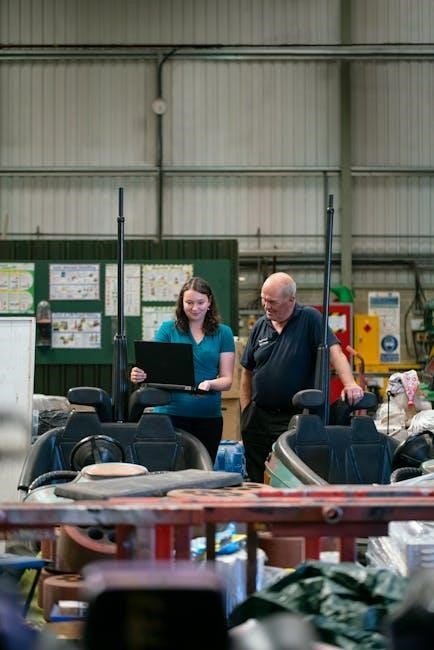
Repair and Replacement Procedures
Follow detailed steps for diagnosing and fixing issues. Use genuine parts for replacements. Ensure safety by disconnecting power before starting repairs. Refer to the manual for specific instructions.
8.1 Disassembling the Washer
Disassembling the Whirlpool WTW4816FW2 washer requires careful planning and adherence to safety guidelines. Start by unplugging the washer and wearing protective gloves. Remove the top panel by unscrewing the retaining clips. Next, disconnect the electrical connections and hoses. Gently lift the tub and set it aside. The drum and bearings can then be accessed for inspection or replacement. Use specialized tools for removing seals and gaskets. Document each step to ensure proper reassembly. Always refer to the manual for specific torque specifications and diagrams to avoid damaging components. Proper disassembly is crucial for effective repairs and maintaining the washer’s performance.
8.2 Replacing Common Parts
Replacing common parts in the Whirlpool WTW4816FW2 washer involves identifying the faulty component and following precise steps. Start by disconnecting power and water supply. For parts like the gasket or drain pump, remove the lower panel and disconnect hoses. Use a wrench to remove bolts securing the part; Install the new component, ensuring proper alignment and sealing. Reassemble in reverse order, tightening bolts securely. For internal parts like bearings or the tub seal, refer to the manual for specific instructions. Always use genuine Whirlpool replacement parts to maintain performance and warranty validity. After replacement, test the washer to ensure proper function and leak-free operation. Regular part replacement helps extend the washer’s lifespan and prevents major repairs.
8.3 Reassembling the Washer
Reassembling the Whirlpool WTW4816FW2 washer requires careful attention to detail to ensure proper function. Begin by reinstalling the internal components in reverse order of disassembly. Align parts precisely, ensuring all connections are secure. Reattach the tub, gasket, and outer panels, tightening bolts evenly. Reconnect electrical and plumbing lines, double-checking for leaks. Once reassembled, run a test cycle to verify operation. Ensure all screws and fasteners are tightened to manufacturer specifications. Proper reassembly is critical for maintaining performance and preventing future issues. Always refer to the manual for specific torque values and alignment guides. After reassembly, inspect the washer for any signs of damage or misalignment before returning it to service. This step ensures reliability and longevity of the appliance.
The Whirlpool WTW4816FW2 Service Manual provides essential guidance for optimal performance and longevity. Proper maintenance and adherence to guidelines ensure efficient operation and extended appliance life.

9.1 Key Takeaways
The Whirlpool WTW4816FW2 Service Manual is a vital resource for users, offering detailed guidance on installation, operation, and maintenance. Key takeaways include proper installation steps, regular maintenance routines, and troubleshooting tips to ensure optimal performance. Understanding safety guidelines and adhering to recommended practices is crucial for longevity. Familiarizing yourself with error codes and diagnostic procedures can help resolve issues quickly. Routine cleaning and part replacements are essential for maintaining efficiency. By following the manual’s instructions, users can extend the lifespan of their washer and ensure reliable operation. This guide empowers users to take control of their appliance’s care, making it an indispensable tool for years of trouble-free service.
9.2 Final Tips for Optimal Performance
To ensure your Whirlpool WTW4816FW2 washer performs at its best, regular maintenance is essential. Clean the gasket and drain pump filter periodically to prevent debris buildup. Always follow the recommended load capacity to avoid imbalance issues. Use high-efficiency detergent to optimize cleaning results and reduce residue. Check and replace worn-out parts promptly to maintain efficiency. Proper ventilation in the laundry area can prevent moisture buildup and mold growth. By adhering to these tips, you’ll extend the washer’s lifespan and enjoy consistent, reliable performance. Remember, consistent care and attention to detail will keep your appliance running smoothly for years to come.























